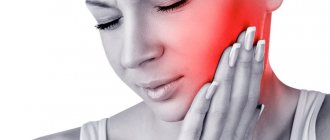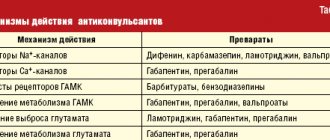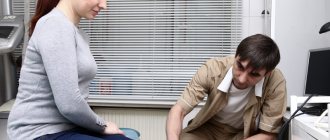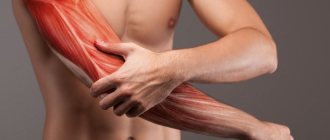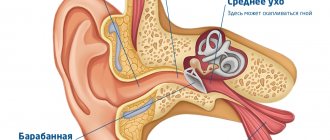Ear pain - mild or intense, shooting or aching - is a symptom that can indicate both a disease of the hearing organ and pathological processes occurring in nearby organs and tissues. According to statistics, otitis media is the most common cause of ear pain. However, the diversity of its forms and many other diseases with similar symptoms require accurate diagnosis and different treatment approaches. To establish the true causes of ear pain, it is necessary to be examined by an otolaryngologist, and sometimes by a neurologist, dentist, and even a cardiologist.
At CELT you can consult an otorhinolaryngologist.
- Initial consultation – 3,000
- Repeated consultation – 2,000
Make an appointment
Otitis externa
Most often, inflammation of the outer ear is bacterial in nature.
The causes of infection may be:
- trauma to the external auditory canal, for example, from a sharp or blunt object, or from a hearing aid;
- skin defects due to eczema, psoriasis, diabetes and other diseases;
- too thorough removal of earwax, which creates an acidic environment that prevents the growth of microbes;
- frequent entry of water into the outer ear (“swimmer’s disease”).
Symptoms of external otitis:
- acute ear pain, aggravated by pressing on the tragus or pulling the earlobe;
- possible itching and a feeling of “stuffiness” in the ear;
- discharge of a purulent or bloody nature, sometimes having an unpleasant odor;
- examination reveals swelling and hyperemia of the external auditory canal;
- possible hearing loss;
- enlargement and tenderness of the lymph nodes in the neck and behind the ear on the affected side.
The course of the disease may be complicated by a perforation of the eardrum, which cannot be determined without a visit to an ENT specialist.
External otitis of fungal origin is a common phenomenon, usually occurring in patients with low immune status or due to long-term use of antibacterial drops. It is characterized by severe itching, the formation of crusts, profuse thick discharge and the absence of a therapeutic effect from the use of antibiotics.
Separately, it is worth noting the localization of a boil on the skin of the external auditory canal or inflammation of the atheroma. The clinical picture is similar to otitis externa, but upon examination there is a more localized focus of inflammation with an opening from which pus and blood can be discharged.
Summer, sun, beach, otitis media
No, this is not a “find the extra word” task. All these concepts are truly interconnected. Medical statistics show that ears hurt more often in the summer. And this is connected with the beginning of the swimming season.
The fact is that getting water (especially dirty water) into the ears dilutes the ear secretion. As a result, the protective function of the ear decreases, which contributes to the development of pathogenic microflora. This is how otitis externa develops. In another way, this inflammation is called “swimmer’s ear.” This disease is a frequent companion of those who are professional swimmers.
Does this mean that you need to deny yourself the pleasure of swimming? Of course not. The disease is not dangerous if it is detected in time and measures are taken.
Otitis media
The middle ear communicates with the nasopharynx through the Eustachian tube, through which infection can penetrate from the upper respiratory tract due to acute respiratory viral infections, influenza, sore throat, rhinitis, sinusitis and other diseases. Children are especially often affected because their Eustachian tube is short and wide, which makes it easier for infection to enter. The process can be one- or two-way.
Symptoms of acute otitis media:
- pain in the ear from moderate to severe, pulsating in nature (pain does not depend on pulling the lobe or pressing on the ear canal);
- increased body temperature;
- possible noise in the ear, dizziness, decreased hearing acuity;
- the presence of discharge (mucous, purulent, bloody) indicates a perforation of the eardrum.
With an aggressive course of the inflammatory process and the absence of adequate therapy, otitis media is fraught with such serious complications as meningitis, sepsis, intracranial abscess formation, and deafness.
Symptoms
The main symptom of the disease is constant discomfort in the ear, spreading to the temporal area. The patient suffers from burning, throbbing and very sharp pain, similar to an electric shock. Other symptoms of inflammation of the ear node are also noted:
- Why does the jaw hurt near the ear on one or both sides, treatment options
- Decreased or complete loss of hearing . The pathological process develops over several hours or days. Deafness can affect only one side or spread to 2 ears at once.
- Extraneous noises . Patients are bothered by a strong ringing in the ear canal, which does not come from external stimuli. In addition to ringing, the patient feels a buzzing, whistling or hissing sound in the ears. The sign of pathology does not appear in cases of severe deafness.
- Dizziness.
- Impaired coordination . In the initial stages of the disease, the symptom is unsystematic. The clinical picture of the disease is complemented by vomiting and spontaneous movement of images with further progression. The reason for the lack of coordination of movement is the involvement of the cochlear nerve, which is responsible for the balance of the body, in the inflammatory process.
- Headache . _ Manifested for neuralgia caused by poisoning with toxic substances.
An attack can be triggered by drinking hot food or drinks, as well as hypothermia on the face. The duration of neuralgic pain varies from a few minutes to 1 hour.
Inflammation of the inner ear (labyrinthitis)
The labyrinth is an organ of hearing and balance, is richly innervated and includes auditory and kinetic receptors, so its inflammation causes:
- severe ear pain and headaches;
- a sharp decrease in hearing, the appearance of noise, crackling, squeaking in the ear;
- dizziness, nausea, loss of orientation in space, horizontal nystagmus.
Labyrinthitis occurs as a result of the penetration of infection in various ways from different parts and cavities of the body:
- from the middle ear with untreated or advanced otitis media;
- with infected meninges during meningitis;
- with blood for diseases such as syphilis, tuberculosis, herpes;
- damage to the temporal region, the organ of hearing with disruption of the integrity of cells and blood vessels.
The disease requires immediate medical attention.
Diagnosis and treatment of ear pain in Moscow
At the appointment, the doctor talks with the patient, collects anamnesis and conducts an examination using an otoscope, assesses the condition of the outer ear, ear canal and eardrum. He examines the pharynx, larynx, oral cavity and nasal passages. Sometimes the patient is referred for audiometry. If the cause of the pain is injury, you will also need to do an X-ray or CT scan.
Ear treatment in Moscow is offered by many medical institutions: from district clinics to multidisciplinary medical centers. The final cost of ear treatment in Moscow depends on the type of medical institution and its pricing policy. "ENT Clinic of Doctor Zaitsev" specializes in diseases of the hearing organs. Treatment of ear diseases is our specialty. We use the most modern equipment from famous world manufacturers. Our doctors' many years of experience allow us to successfully diagnose hearing pathologies and offer the most effective treatment. Prices for our services have not changed for more than three years.
If ear pain and other unpleasant symptoms appear, do not tolerate it and do not self-medicate. Please call, make an appointment and come. We will be happy to help you!
Eustachite
Eustachitis is an inflammation of the canal connecting the middle ear to the nasopharynx. The degree of pain varies. Characteristic features are:
- feeling of stuffiness in the ear;
- noise and crackling in the ear, the patient hears his voice as too loud with a weakened perception of extraneous sounds;
- sensation of water pouring into the ear.
In the absence of timely treatment, eustachitis becomes chronic, causing chronic exudative otitis media.
Ear compresses for the right and left ears
In addition to drug treatment, patients are advised to use warm ear compresses based on alcohol or camphor oil. To prepare them you will need:
- Compress with camphor oil - cut a hole in the center of the gauze napkin into which the ear could fit. Next, soak a napkin with camphor oil, wring it out and apply it to the sore ear, threading it through the hole. Finally, apply cotton wool and secure the compress with a bandage. The compress is replaced every hour (but can be left overnight).
- Alcohol compress - 20-25% alcohol is diluted with water (1:1) and a gauze cloth is moistened in it, then the compress is applied to the ear in the same way as described above and kept for 30-40 minutes.
a cut is made in the gauze for the ear.
Before applying an alcohol compress, the skin around the ear is first lubricated with a thick cream (so as not to cause a burn). If the patient's body temperature is higher than normal, then any warming compresses are contraindicated .
Ear pain of non-infectious origin
Ear tumors
Neoplasms are most often localized in the outer and middle sections; tumors of the labyrinth are an extremely rare phenomenon. Malignant formations of the outer ear are accompanied by severe pain: the pain is burning and radiates to the temple. Possible bleeding; When the ear canal is obstructed, conductive hearing loss develops. If the middle section is affected, the symptoms are similar to otitis media; a high degree of hearing loss and intense pain, increasing in the evening, should alert you. When the process spreads, symptoms of damage to neighboring structures arise: loss of orientation in space, paresis of the facial nerve, trigeminal neuralgia.
Ear injuries
- Mechanical injuries. The auricle most often suffers with the formation of lacerations and damage to cartilage. Blunt trauma to the ear usually results in a hematoma. As a result of trauma to the ear canal, the ear hurts greatly, there is a feeling of stuffiness, and bleeding is possible. Such symptoms are an indication to consult a doctor, since rupture of the eardrum and fractures of the skull bones are possible.
- Barotrauma is caused by a difference in pressure in the external environment and the cavity of the middle ear, for example, during a sharp loud sound (explosion), take-off/landing of an airplane, deep-sea immersion (diving), climbing a mountain. As a result, the eardrum is pulled inward, which is accompanied by pain, noise or ringing, and congestion in the ears. The opposite situation is also possible, when a decrease in atmospheric pressure causes the membrane to bulge outward. As a rule, unpleasant sensations go away on their own, however, if sharp pain is noted, it makes sense to check the integrity of the tympanic membrane when examined by a doctor.
- Entry of a foreign body in the form of small objects or insects causes swelling of the skin of the ear canal, itching, pain, and sometimes hearing loss. Attempting to remove a foreign object yourself can damage the eardrum.
- With burns and frostbite of the ears, **pain // of varying intensity is observed, depending on the degree of damage.
- Conventionally, ear injuries include the formation of wax plugs, which irritate the skin of the ear canal, causing discomfort and tinnitus. Removal should be carried out by an otolaryngologist.
How to treat a sore ear?
First, contact an otolaryngologist (ENT). Self-medication can lead to aggravation of the disease, which could be easily cured. There are types of inflammations that absolutely cannot be heated and in general it is better not to touch them yourself. As we mentioned above, the causes of otitis media are different. Only a professional can understand them.
Diagnosis of ear diseases is carried out using otoscopy (a special device or funnel is inserted into the ear), hearing examination and ear discharge. To find the source of the infection, your doctor may order a blood test.
Then the specialist will choose a treatment for you. Depending on the nature of the inflammation, antibiotics, antibacterial drugs, antihistamine (anti-allergenic) tablets, anti-inflammatory and restorative agents are prescribed.
In addition to the main treatment, a specialist may prescribe herbal decoctions and special solutions. They are applied to a cotton swab and placed in the ear.
Methods of physiotherapy and UHF therapy (using current) are also used. Sometimes it is necessary to open the boil surgically.
Ear pain due to diseases of other organs
- Mastoiditis - inflammation of the mastoid process - causes intense throbbing pain in the ear, swelling of the tissue behind the auricle, hearing loss, and hyperthermia.
- With arthrosis and arthritis of the temporomandibular joint, the patient is bothered by shooting pains in the ear, which intensify when chewing, a crunching sound in the temple area, and over time, hearing impairment and malocclusion are possible.
- Mumps is an inflammation of the salivary gland located in front of the auricle, accompanied by acute pain in the ear, aggravated by swallowing and chewing, and swelling of the tissues.
- Inflammation of the parotid lymph nodes (lymphadenitis) develops when infection penetrates into them from diseased teeth or from other foci of inflammation.
- Inflammatory diseases of the nasopharynx and sinuses, malignant processes in the larynx and oral cavity are often accompanied by pain in the ear when swallowing.
- Caries, pulpitis. Since the organ of hearing, like the teeth, is innervated by the branches of the trigeminal nerve, damage to the teeth and jaw may be accompanied by pain in the ear area.
- An atypical form of heart attack, when the patient’s only subjective complaint is pain in the ear.
Sulfur plugs
Earwax is an accumulation of earwax in the ear, which subsequently hardens and causes discomfort, tinnitus appears, and hearing loss decreases. In a healthy person, excess sulfur is removed spontaneously, for example, when chewing. But in some people, wax cannot be removed on its own; it accumulates near the ear canal, hardens and forms a plug. There is no need to try to get rid of the cork on your own, much less try to remove it with sharp objects (matches, toothpicks, etc.) - damage to the tissues of the shell or eardrum cannot be avoided in this case. The plug is removed by an ENT doctor. The procedure does not take much time: first he softens the plug with oil or solutions, and then rinses it with a special syringe or removes the sulfur plug with a special Wojacek hook.
Diagnostics
The diagnosis and treatment of pathologies associated with this symptom is carried out by an ENT doctor (otorhinolaryngologist) or an audiologist (a narrower specialty in otorhinolaryngology). During the appointment, the specialist talks with the patient, examines him, conducts the necessary examination, and establishes a diagnosis.
The multidisciplinary CELT clinic employs experienced, highly qualified otolaryngologists. Rich clinical experience helps them make the correct diagnosis in the most difficult cases.
Prevention
Preventive procedures involve eliminating factors that cause pathology:
- Identify and eliminate pathologies of the ENT organs in a timely manner, without leading to relapses.
- Do not use ototoxic drugs.
- Patients who constantly interact with complex production factors should undergo audiometry 2 times a year.
- We need a healthy lifestyle.
- Multivitamins should be taken in spring and autumn.
- Ears need to be covered with something in production where it is noisy.
- Use a hat in winter.
Our doctors
Gogolev Vasily Gennadievich
Doctor - otorhinolaryngologist
19 years of experience
Make an appointment
Zharova Galina Gennadievna
Doctor - otorhinolaryngologist, member of the European Society of Rhinologists, doctor of the highest category
Experience 39 years
Make an appointment
Debryansky Vladimir Alekseevich
Doctor - otorhinolaryngologist, doctor of the highest category
33 years of experience
Make an appointment
At an appointment with an ENT doctor
Consultation with an otolaryngologist is necessary if discomfort continues for more than a day. At the appointment, the ENT doctor will conduct a hardware examination, prescribe additional examination if necessary, establish a diagnosis, and remove cerumen or a foreign object.
The doctor will prescribe analgesics, antispasmodics, and non-steroidal anti-inflammatory drugs to relieve pain during the inflammatory process. Symptomatic therapy is selected individually for each patient.
At the ENT CLINIC in Chertanovo, doctors will provide the necessary assistance - they will conduct a video endoscopy examination to visualize the source of inflammation, perform the necessary additional examination methods (tympanometry), and individually select a treatment regimen, including modern physiotherapeutic techniques, widely presented in the clinic.
Treatment
Treatment of inflammatory ear diseases includes:
- antibacterial, antiviral agents of local and general action;
- antipyretics, analgesics;
- physiotherapy;
- in some cases - surgical intervention.
Treatment must be based on accurate diagnosis, which is impossible outside a specialized clinic. The high professionalism of CELT specialists allows us to identify various diseases of the hearing organ and choose the most effective means of solving the problem.
Make an appointment through the application or by calling +7 +7 We work every day:
- Monday—Friday: 8.00—20.00
- Saturday: 8.00–18.00
- Sunday is a day off
The nearest metro and MCC stations to the clinic:
- Highway of Enthusiasts or Perovo
- Partisan
- Enthusiast Highway
Driving directions
Ear pain - what to do?
As we can see, pain syndrome has a different nature of occurrence. Only a doctor can understand the real cause, establish the correct diagnosis and offer an effective treatment for ear pain in adults. An otolaryngologist treats ear diseases in adults. If you encounter such a problem, immediately contact a specialist.
Unfortunately, it is not always possible to visit a doctor right away. More often, unpleasant symptoms appear suddenly and at night. First of all, you need to take a pain reliever - an ibuprofen-based painkiller. It has anti-inflammatory properties and is most effective compared to other drugs.
If pain is accompanied by a runny nose, it would be a good idea to use vasoconstrictor nasal drops.
The first thing many patients do is run and buy ear drops for pain. But each drop has its own purpose: in one case they can fully treat, in another - not. Drops are not a universal remedy. Statistics show that when treating ears, in half of the cases patients mistakenly prescribe medications to themselves. Drops should be used only when you are completely confident in your diagnosis.
Drops will not help with injury - in such a situation it is better to take a painkiller and consult an ENT doctor. Heat compresses should not be used before consulting a doctor. For example, with purulent otitis, such a measure will only worsen the patient’s condition.
Before visiting a doctor, do not go out into the cold without a hat, do not try to clean the ear from secretions and pus in its depths on your own, and do not instill alcohol-based products.
As a rule, for ear infections of the middle ear, antibacterial agents are prescribed. For external inflammation - antibiotics in the form of drops. In any case, consultation with an ENT specialist is mandatory! Folk remedies can be used in combination with drug therapy and only after an accurate diagnosis, that is, after visiting a doctor.
General description of the condition
The official name of the pathology is “cranialgia”. There is no need for provoking reasons for the appearance of paresis; pain occurs on its own unexpectedly. The anomaly can be characterized by the following features:
- a sudden painful impulse lasting from a few seconds to many hours (sometimes persistent);
- high intensity of pain, further intensifying when moving the eyeballs;
- it is impossible to touch the affected area, analgesics are also powerless;
- The temporal and occipital region suffers most often;
- there is a possibility of fever or vomiting;
- irradiation to the shoulder girdle, neck, shoulder blades;
- twitching sensations in the ears when hearing sounds;
- touching the face, smiling, coughing lead to new lumbago, “bell blows” inside the skull;
- arms and legs become numb, muscles are pulled, gait becomes swaying;
- gradually developing apathy to what is happening around, all thoughts are occupied with pain.
In the chronic course of the pathology, when it manifests itself quite often, intellectual and psychological changes occur, since pain displaces all other sensations and emotions. A person is busy only with himself, constantly expects an attack, becomes irritable, loses interest and the ability to remember basic data (for example, the security code of a plastic card or his telephone number).
Briefly about the ear
Forming an idea of the structure of the ear allows you to understand in which parts pain may occur and what causes it. The organ is one of the most complex in the human body; it consists of three sections:
- Outer ear. This area includes what is accessible for visual inspection without the use of additional devices. We are talking about the concha and the visible part of the ear canal;
- Middle ear. This part is hidden from view and includes the tympanic cavity and the auditory ossicles. Protection of this section is provided by the temporal bone;
- Inner ear. This is the most complex section; its components are represented by bone canals. Its task is to convert incoming sounds into impulses that are transmitted to the brain and recognized there. Also, this department includes the vestibular apparatus, which is responsible for human coordination and balance.
